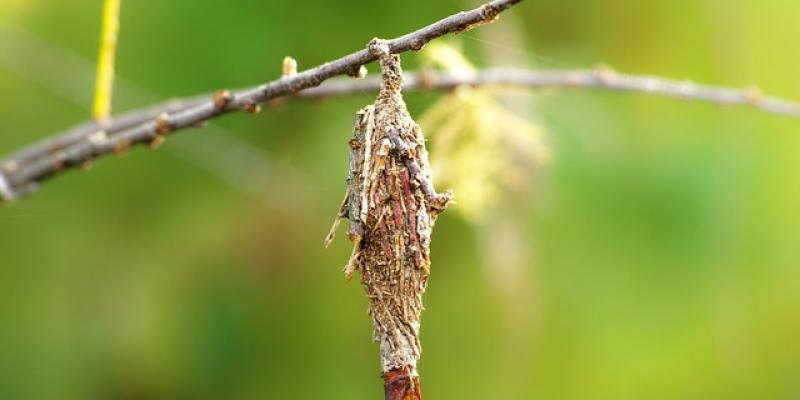How to Get Rid of Bagworms & Spittle Bugs
 Last updated: 6/5/23
Last updated: 6/5/23
Estimated read time: 4 minutes
Bagworms and spittle bugs feed on more than 120 plant species and are known to defoliate an entire tree if left untreated, so kudos to you for looking for ways to get rid of these insects.
Our soil scientists understand that your trees and shrubs would be costly to replace, so we have compiled the most frequently asked questions about bagworms and spittle bugs so you can learn about these insects and prevent them from eating through your investments.
Frequently Asked Questions About Bagworms
What are bagworms?
Bagworms (Thyridopteryx ephemeraeformis), also known as evergreen bagworms, are not worms at all—rather they are caterpillars that are known for their unique shelters. These insects spend the majority of their lives inside cocoon-like bags that are about 1.5 to 2 inches long. These bags are spun out of silk and strengthened using camouflaging bits of foliage, such as pine needles, twigs, leaves, or pieces of bark.
What do Bagworms look like?
 Bagworms make 1.5 to 2-inch long spindle-shaped bags that can be seen hanging from twigs of trees and shrubs. Sometimes the bags are mistaken for pine cones or other plant structures. Don’t be fooled, these caterpillars feed on 120+ including yours.
Bagworms make 1.5 to 2-inch long spindle-shaped bags that can be seen hanging from twigs of trees and shrubs. Sometimes the bags are mistaken for pine cones or other plant structures. Don’t be fooled, these caterpillars feed on 120+ including yours.
What trees do bagworms like?
While the bagworm larvae are known to attack over 120 different types of trees, some of the preferred host plants include:
- Apple
- Arborvitae
- Black locust
- Basswood
- Box-elder
- Eastern red cedar
- Elm
- Honey locust
- Indian hawthorn
- Juniper
- Ligustrum
- Maple
- Oak
- Persimmon
- Pine
- Poplar
- Spruce
- Willow
How long do bagworms live?
Bagworm caterpillars hatch from eggs in late spring to early summer and emerge as small, black larvae, about 1/25 inches long. The young insects spin strands of silk into a simplistic parachute and use it to travel to nearby trees and tall shrubs in a process known as “ballooning”. Once they have found a reliable food source, the caterpillars start building their bags, which they carry around with them. Over the course of the summer, the larvae feed on nearby foliage, expanding their bag as they grow.
In late summer or early fall, the mature larvae securely attach their bags to a nearby tree and retreat to transform into a pupa, emerging as adult bagworms shortly after. The females appear soft-bodied and grub-like and remain in their bag, while adult male bagworms emerge as ashy-black moths with transparent wings, measuring about 1 to 2 inches. The male moths leave their bags to find flightless females and mate, after which the females lay anywhere from 300 to 1,000 eggs inside their bag before departing and dying. The eggs survive the winter within the bag, hatching in the spring to restart the year-long life cycle of the bagworm.
Are Bagworms and Sodworms the same?
No, bagworms and sodworms are not the same insects. Many people get them confused as they both spin silk, but they are different bugs. While the average person will use the term interchangeably, or even names like “webworms” and “tent caterpillars,” the biggest difference is the time of year in which they spin their silk and where they spin it. If you’re confused about which bug you have, a professional will be able to tell and properly treat it.
Are bagworms harmful to humans?
While bagworms are not harmful to humans, they can have a devastating effect on your landscape. Between spring and mid-August, the larvae feed on nearby foliage of both evergreen and deciduous trees.
- Evergreen: The caterpillars attack buds and foliage, eventually causing the branches to turn brown and die off. If bagworms damage more than 80% of the tree, the evergreen can not be saved.
- Deciduous: While feeding, the larvae will chew small holes into the leaves, causing them to die off. As deciduous trees lose their leaves every year, they are generally able to bounce back if you prevent the pests from returning in the next year.
On top of damaging foliage, the silk thread that is used to attach bags is left behind on the branch after the larvae hatch and can girdle the branch as it grows, causing it to die off slowly.
How do you get rid of bagworms?
The best time to get rid of bagworms is in late winter or very early summer before the eggs hatch, as it is nearly impossible to kill the pest by early July when the larvae are longer than ½ inch.
Hand-Picking Bagworms
While some people recommend hand-picking bags containing bagworm eggs and putting them in soapy water, this is not very effective. Not only is it easy to miss bags that can easily contain hundreds of eggs, but simply pulling the bag off will leave the silk thread, which will girdle the branch and eventually kill it. If you are choosing to hand-pick the bags, make sure to use a sharp knife or shears to remove the silk thread.
Cutting off Branches
If you noticed a specific branch that has a heavy bagworm infestation, it may be best to cut off the entire branch and drop it in soapy water to prevent the pests from spreading. This method of bagworm control is somewhat effective, though unpopular with many homeowners.
Spraying for Bagworms
An effective DIY treatment against the insects is using chemical control. We recommend using pyrethroid insecticides—especially Bacillus thuringiensis, commonly known as Bt, a bacteria spray harmless to pets and children. While spraying, make sure to thoroughly cover the area. If the host plant is heavily infested, two applications may be necessary, preferably two weeks apart.
Hiring a Professional
The best way to protect your trees and shrubs from bagworms is by consulting a professional pest and lawn control service, such as Blades of Green. With over 30 years of experience, our locally-owned company offers expert bagworm treatments and offers you a tree and shrub plan to prevent future problems.
Do you offer bagworm treatment?
Bagworms feed on more than 120 plant species and are known to defoliate an entire tree if left untreated. Trees are incredibly expensive to replace.
To help you protect your investments we provide professional bagworm treatment:
- Oil treatment to prevent insects
- Slow-release fertilizer application for root development and foliage growth
- Insect and disease prevention
- Tailored nutrient application
- Root injection to plants at risk for pests
- Selective fertilization applications, unique to ornamental trees and shrubs
- Wax coat application to prevent weather damage
Frequently Asked Questions About Spittle Bugs
What are spittle bugs?
Spittle bugs, also known as froghoppers, are small insects belonging to the family Cercopidae. They are named after the protective foam-like substance they produce, resembling spit or froth, which serves as a hiding place for the nymphs.
Are spittle bugs harmful to plants?
Generally, spittle bugs are not considered highly destructive to plants. They feed on the sap of a variety of plants, but their feeding activities rarely cause significant damage. However, in large numbers, they can affect the overall health and vigor of plants.
How can I identify spittle bug infestation?
The presence of spittle bug nymphs is often the most noticeable sign of an infestation. They are small, greenish insects that reside within the frothy mass they create. Sometimes, you may also notice patches of foam or froth on plant stems or leaves.
How can I control spittle bug populations in my garden?
You can handpick nymphs or spray them off with a strong stream of water. In severe cases, insecticidal soaps or botanical insecticides can be used.
Do spittle bugs bite humans?
No, spittle bugs do not bite humans. They primarily feed on plant sap and have no interest in biting or stinging people. They are harmless to humans and do not transmit any known diseases.
Send The Pests Packing
Quick Quote Form
"*" indicates required fields
